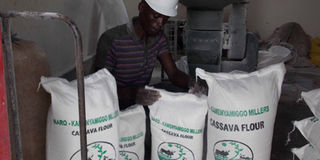Naro station teaches cassava farmers to add value

Bags of cassava flour packed at Kamenyamiggo station. Photo by Michael J Ssali
Naro’s Kamenyamiggo Satellite Station has set up a component under its research programme to teach farmers in the region on how to add value to cassava.
The target is individual farmers and farmers’ groups in Masaka, Lwengo, Bukomansimbi, Kalungu, Lyantonde and Rakai districts.
Among the things to be demonstrated to the farmers is how to make flour from cassava tubers and how to package it for marketing.
“The idea is to enable farming households in the region to keep and preserve cassava as food for longer periods and to enhance food security as well as increasing household incomes,” said Dr Nicholas Ssekabunga, the farm manager.
Avoid contamination
The station currently has 100 acres of the early maturing Nase 14 cassava, which is tolerant to most diseases including cassava mosaic and brown streak diseases. There is also a seed multiplication centre for the cassava.
Dr Ssekabunga added that cassava tubers for making flour are best harvested a year after planting. The farmer should carry out what is known as piece-meal harvesting—that is getting a tuber or two from each plant in the field.
During harvesting, every effort must be made to avoid bruising the tuber. Bruising or cutting the tubers contaminates them with soil particles, which spoils the flour later and make it unattractive to eat.
Proper methods
The tubers should be taken to the collecting centre quickly where they are peeled and then washed three times, in three separate water containers, before they are cut into small chips and spread over a clean tarpaulin sheet for drying under the sun.
“We strongly discourage farmers from drying the chips on the bare ground, where it gets into contact with the soil and, in some cases, animal droppings yet it ends up as food for human consumption,” he said.
Ssekabunga explains that when the cassava chips are dry, they are put into a milling machine which turns them into flour.
Besides its other activities, the NARO Kamenyamiggo station makes cassava flour, which it sells to traders.
There is a big demand for cassava flour and if the farmers take up value addition they will find it very paying.




